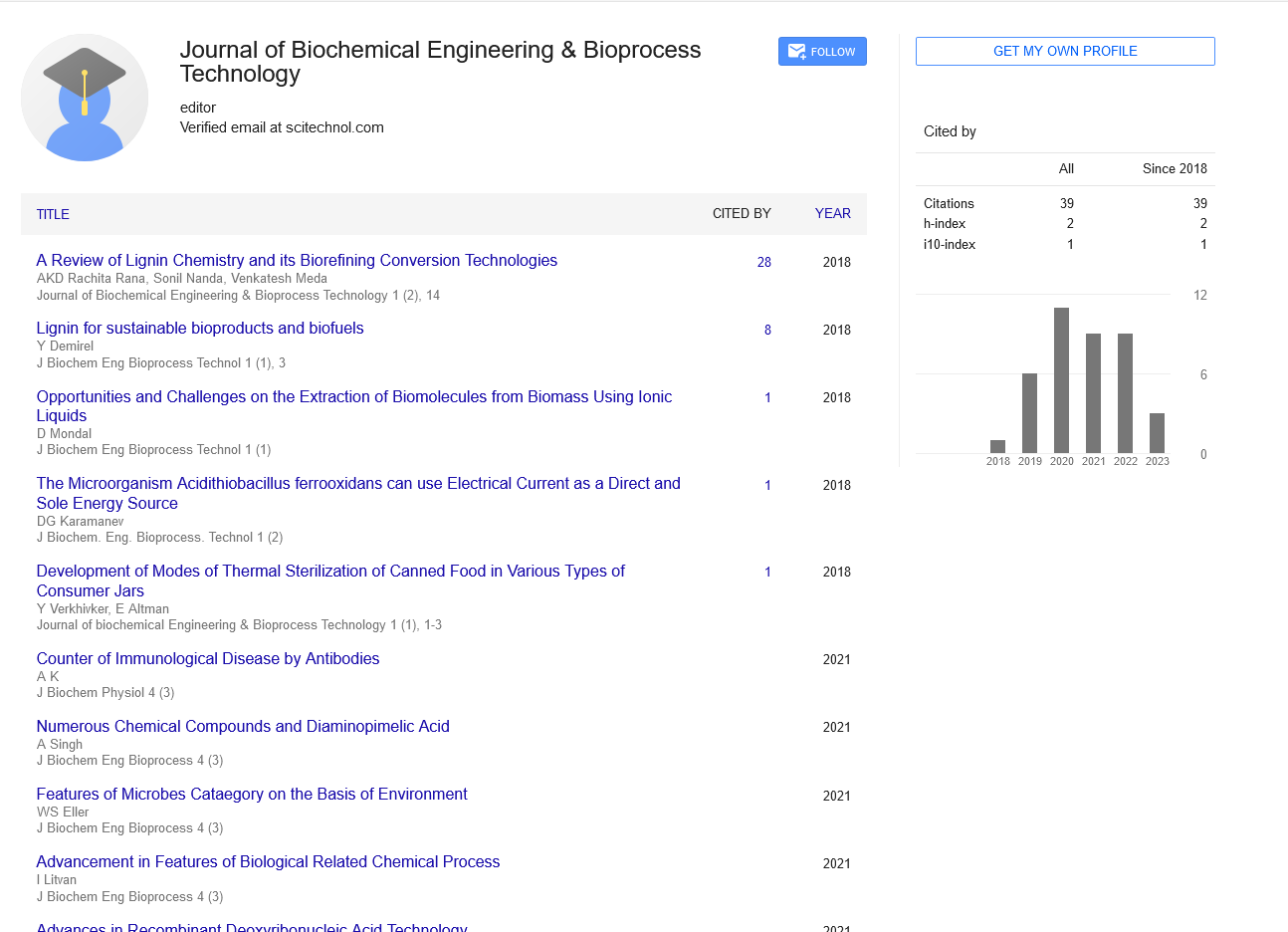Perspective, J Biochem Eng Bioprocess Vol: 6 Issue: 2
Biocatalysis at the Forefront: Strategies and Applications in Biochemical Engineering
Jaxon Orion*
1Department of Biochemical Engineering & Bioprocess Technology, University of Cambridge, Cambridge, UK
*Corresponding Author: Jaxon Orion,
Department of Biochemical Engineering & Bioprocess Technology, University of Cambridge, Cambridge, UK
E-mail: orionj@gmail.com
Received date: 22 May, 2023, Manuscript No. JBEBT-23-106920;
Editor assigned date: 24 May, 2023, Pre QC. JBEBT-23-106920 (PQ);
Reviewed date: 15 June, 2023, QC No. JBEBT-23-106920;
Revised date: 22 June, 2023, Manuscript No. JBEBT-23-106920 (R);
Published date: 29 June, 2023, DOI: 10.35248/jbebt.1000058.
Citation: Orion J (2023) Biocatalysis at the Forefront: Strategies and Applications in Biochemical Engineering. J Biochem Eng Bioprocess
Keywords: Bioprocess
Description
Biocatalysis, the use of natural catalysts such as enzymes and whole cells, is gaining significant attention in biochemical engineering due to its potential for sustainable and efficient production processes. This study provides a brief overview of the recent advancements in biocatalysis and explores novel strategies and applications in the field of biochemical engineering. It discusses the utilization of enzymes, immobilized biocatalysts, and engineered microorganisms for various biotransformation processes. Furthermore, the study highlights the emerging trends in biocatalysis, including the integration of biocatalysts with synthetic biology and nanotechnology, and their potential in advancing bio-based industries.
Enzyme biocatalysis: Expanding horizons
Enzymes are versatile biocatalysts widely used in biochemical engineering. This section explores recent developments in enzyme biocatalysis, including the discovery and engineering of novel enzymes with enhanced properties. It discusses strategies such as directed evolution, rational design, and enzyme immobilization for improving enzyme stability, activity, and selectivity. Additionally, the section highlights the use of enzyme cascades and multi-enzyme systems to perform complex transformations efficiently.
Immobilized biocatalysts: Enhancing stability and reusability
Immobilization techniques enable the attachment of biocatalysts onto solid supports, enhancing their stability and facilitating their reuse. This section explores various immobilization strategies, including encapsulation, covalent attachment, and adsorption onto surfaces or porous materials. It discusses the advantages of immobilized biocatalysts, such as improved operational stability, enhanced product yield, and simplified downstream processing.
Additionally, the section highlights the use of immobilized enzymesand cells in continuous flow systems for continuous biotransformation processes.
Engineered microorganisms: Tailored biocatalysts
Genetic engineering has enabled the development of engineered microorganisms with enhanced biocatalytic capabilities. This section discusses the engineering of microbial hosts for specific biotransformation processes. It explores strategies such as metabolic pathway engineering, gene overexpression, and knockouts to optimize microbial physiology and enhance target compound production. The section also highlights the integration of synthetic biology tools, such as genetic circuits and regulatory elements, to fine-tune and control biocatalytic activities in engineered microorganisms.
Biocatalysis in synthetic biology and nanotechnology
The integration of biocatalysis with synthetic biology and nanotechnology opens up new possibilities in biochemical engineering. This section discusses the use of synthetic biology tools, such as biosensors, genetic switches, and orthogonal translation systems, to design and control biocatalytic pathways. It also explores the application of nanomaterials, such as nanoparticles and nanocomposites, for enhancing biocatalyst immobilization, stability, and catalytic efficiency. Furthermore, the section highlights emerging trends in the development of biohybrid systems, where biocatalysts are combined with synthetic components or nanomaterials to achieve enhanced functionality and efficiency.
Applications in bio-based industries
Biocatalysis finds diverse applications in bio-based industries, including pharmaceuticals, biofuels, fine chemicals, and food processing. This section provides examples of successful applications, such as enzymatic synthesis of pharmaceutical intermediates, enzymatic biofuel production, and biotransformation of natural compounds. It also discusses the potential of biocatalysis in enabling sustainable and green manufacturing processes, reducing the reliance on fossil fuels, and minimizing the environmental footprint of chemical synthesis.
Conclusion
Biocatalysis is at the forefront of biochemical engineering, offering novel strategies and applications for sustainable and efficient production processes. Recent advancements in enzyme biocatalysis, immobilized biocatalysts, and engineered microorganisms have revolutionized the field. The integration of biocatalysis with synthetic biology and nanotechnology further enhances the potential of biocatalytic systems. By enabling selective and environmentally friendly transformations, biocatalysis contributes to the development of bio-based industries. Continued research have capacity to unlock new biocatalysts, optimize biotransformation processes, and drive the transition towards a more sustainable and resource-efficient future.
 Spanish
Spanish  Chinese
Chinese  Russian
Russian  German
German  French
French  Japanese
Japanese  Portuguese
Portuguese  Hindi
Hindi 